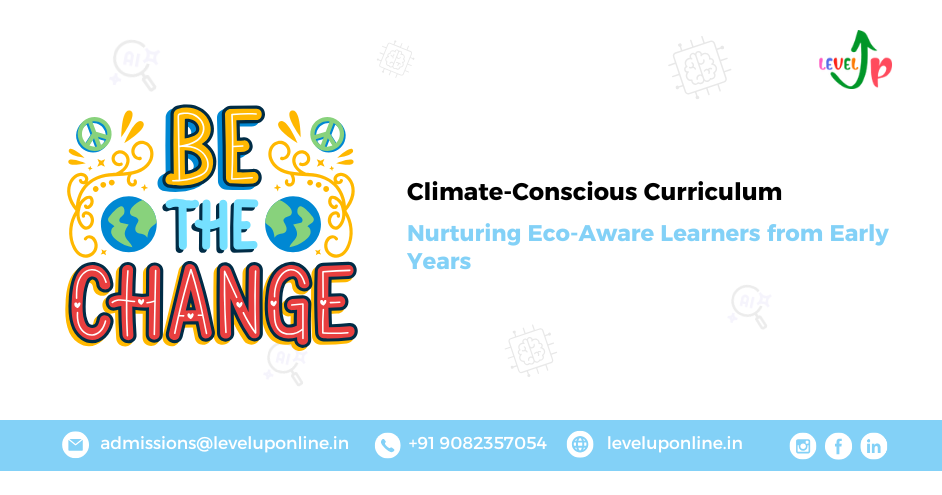Introduction
In today’s world, educating young children about the environment isn’t just a trend—it’s a necessity. The climate-conscious curriculum in ECCE (Early Childhood Care and Education) is a fresh, impactful approach designed to nurture responsible global citizens from their very first learning years. As educators and parents, this is our opportunity to prepare the next generation not just to survive the future—but to shape it.
Why Early Childhood is the Right Time
You might wonder, why start so early? Well, children between 0–8 years are like sponges—what they absorb now will stay with them forever. That’s why introducing them to eco-friendly habits, nature appreciation, and sustainability during this phase is crucial. Through a climate-conscious curriculum in ECCE, we’re not only teaching but shaping values, habits, and empathy toward the environment.
What is a Climate-Conscious Curriculum in ECCE?
A climate-conscious curriculum in ECCE goes beyond teaching the names of animals or colors of the sky. It’s about weaving sustainability into every learning moment. It promotes:
1. Appreciation of the natural world
2. Understanding human impact on nature
3. Simple actions like waste sorting, saving water, or planting trees
4. A mindset that values the planet’s well-being
This curriculum doesn’t ask children to be climate activists—but it teaches them to care.
Connecting Nature with Learning
Children learn best through experiences, and nothing beats the learning that happens under the open sky.
Outdoor Classrooms
Taking learning outdoors makes nature the teacher. Whether it’s observing insects or drawing trees, nature becomes an active learning space.
Hands-on Learning
Activities like planting, watering, or collecting leaves teach responsibility and curiosity. It builds a bond with the environment from a young age.
Sustainability Starts in the Sandpit
Play is powerful. That’s why climate-conscious curriculum in ECCE emphasizes eco-play.
1. Use of recycled materials for crafts
2. Toys made of natural materials like wood and cloth
3. Encouraging kids to reuse boxes, bottles, and fabric scraps in play
It’s not just play—it’s building an eco-conscious mindset.
Integrating Climate Education with Core Subjects
Let’s be real—climate education doesn’t have to be a separate subject. It blends beautifully into regular ECCE activities:
1. Language: Climate-themed storytelling, songs about rain, animals, or seasons
2. Math: Counting seeds, sorting leaves, measuring water usage
3. Science: Simple cause-effect like what happens when a plant gets sunlight
4. Art: Using natural elements like twigs, leaves, and flowers for painting
Through a climate-conscious curriculum in ECCE, every activity can carry a deeper message.
Role of Educators in ECCE Climate Education
Educators are the heart of this change. For a climate-conscious curriculum in ECCE to work:
1. Teachers need basic training in environmental awareness
2. Role modeling eco-behaviors—using cloth bags, avoiding plastic
3. Encouraging child-led questions about nature and change
A confident, passionate educator creates inspired learners.
Parent Involvement in Climate-Conscious ECCE
It doesn’t stop at school. In fact, most eco-habits are absorbed at home. Parents can support by:
1. Setting up waste segregation bins
2. Involving kids in balcony gardening
3. Choosing books and toys that align with sustainability
4. Reducing screen time and encouraging nature walks
The stronger the school-home eco loop, the better the impact.
Benefits of a Climate-Conscious Curriculum in ECCE
It’s not just about saving the planet—it’s about shaping emotionally intelligent, aware, and adaptable humans.
1. Empathy: For animals, trees, and other people
2. Responsibility: Kids learn their actions matter
3. Resilience: Adapting to seasons, delays, and unpredictability
The climate-conscious curriculum in ECCE fosters personal growth while promoting global awareness.
Marketing ECCE with a Climate-Conscious Focus
Let’s talk real. Parents today are looking for more than alphabets and numbers. They want purpose-driven learning. So as an ECCE provider:
1. Highlight your eco-friendly approach in brochures and websites
2. Share photos of nature-based activities on social media
3. Organize tree-planting or zero-waste days and involve parents
4. Use keywords like “climate-conscious curriculum in ECCE” in all digital campaigns
It not only builds your brand—it builds trust.
Real-World Examples and Case Studies
Take NatureNest Preschool (fictional name)—after integrating a climate-conscious curriculum in ECCE, they noticed:
1. Children were more curious during nature time
2. Parents appreciated the holistic approach
3. They gained media attention for their eco-projects
These real stories inspire action, not just admiration.
Challenges and Solutions
Of course, it’s not always smooth sailing.
1. Curriculum overload? Integrate, don’t add. Weave climate awareness into existing lessons.
2. Teacher resistance? Provide short, practical training—not heavy theory.
3. Low-resource settings? Use free resources—nature, recycled materials, stories.
It’s about creativity, not complexity.
Future of ECCE in a Changing Climate
Climate awareness in ECCE is no longer optional. It’s becoming policy-supported and globally encouraged. With Gen Alpha parents (born post-2010s) being more eco-conscious, the demand for climate-focused ECCE will only rise.
Being an early adopter gives your school the edge.
Final Thoughts
A climate-conscious curriculum in ECCE isn’t just a noble idea—it’s a necessary shift. We owe it to our children to teach them the value of what can’t be rebuilt—nature. With little minds learning big values, we’re not just teaching. We’re transforming the future.


